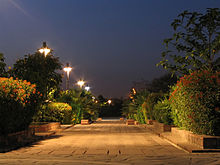Night photography



Night photography generally refers to photographs taken outdoors between twilight and dusk. Originally night photographers had a choice between using artificial light or leaving the camera on a tripod and using a long shutter exposure, often for seconds or even minutes per exposure, in order to give the film enough time to capture enough light to record a proper exposure.
As of today, with the progress of films and lenses and the increasing power of urban lights, night photography can often be achieved using available light, however this does not make the use of long exposures or a flash obsolete.
History
In the early 1900s a few notable photographers, Alfred Stieglitz and William Fraser, began working at night. But the first photographers known to have produced a large body of work at night were Brassai and Bill Brandt. In the 1930s, Brassai published a noteworthy book, Paris de Nuit, of black-and-white photographs of the streets of Paris. During World War II, the British photographer Bill Brandt took advantage of the black-out conditions to photograph the streets of London by moonlight.
In the late 1970s, Steve Harper taught the first college-level course on night photography at the Academy of Art College in San Francisco. The legacy of this program has led to San Francisco becoming one of the core centers of night photography.
By the 1990s, British-born photographer Michael Kenna had established himself as the most commercially successful night photographer. His black-and-white landscapes were most often set between dusk and dawn in locations that included San Francisco, Japan, France, and England. Some of his most memorable projects depict the Ford Motor Company's Rogue River plant, the Ratcliffe nuclear power station in northern England, and many of the Nazi concentration camps scattered across Germany, France, Belgium, Poland and Austria.
During the beginning of the 21st century, the popularity of digital cameras made it much easier for beginning photographers to understand the complexities of photographing at night. Today, there are hundreds of websites dedicated to night photography.
For a more complete history of night photography, refer to Lance Keimig's A History of Night Photography.
Technique and equipment
The following techniques and equipment are generally used in night photography.
- A tripod is usually necessary due to the long exposure times. A very steady hand may suffice for exposures up to around 1/6th of a second. Alternatively, the camera may be placed on a steady, flat object e.g a table or chair, low wall, window sill, etc.
- A shutter release cable or self timer is almost always used to prevent camera shake when the shutter is released.
- Often small apertures to maximise depth of field or average apertures to maximise sharpness, for example f/5.6 to f/16.
- Manual focus, since autofocus systems usually operate poorly in low light conditions.
- Slow film or low ISO setting on a digital sensor to minimize grain (or digital noise) and increase exposure tolerance as evaluating exposure is often tricky.
Subjects
- Streets, with or without cars
- City skylines
- Monuments and statues
- Factories and industrial areas, particularly those that are brightly lit and emitting smoke or vapour
- Fireworks
- Nightlife or rock concerts
- Bodies of water (lakes, rivers, canals, etc) reflecting city lights
Significant published night photographers
This section includes significant night photographers who have published books dedicated to night photography, and some of their selected works.
- Brassai
- Paris de Nuit, Arts et metiers graphiques, 1932.
- Jeff Brouws
- Inside the Live Reptile Tent, Chronicle Books, 2001. ISBN 0-8118-2824-7
- Alan Delaney
- London After Dark, Phaidon Press, 1993. ISBN 0-7148-2870-X
- Neil Folberg
- Celestial Nights, Aperture Foundation, 2001. ISBN 0-89381-945-X
- Karekin Goekjian
- Light After Dark, Lucinne, Inc. ASIN B0006QOVCG
- Todd Hido
- Outskirts, Nazraeli Press, 2002. ISBN 1-59005-028-2
- Rolfe Horn
- 28 Photographs, Nazraeli Press. ISBN 1-59005-122-X
- Brian Kelly
- Grand Rapids: Night After Night, Glass Eye, 2001. ISBN 0-9701293-0-0
- Michael Kenna
- The Rouge, RAM Publications, 1995. ISBN 0-9630785-1-8
- Night Work, Nazraeli Press, 2000. ISBN 3-923922-83-3
- William Lesch
- Expansions, RAM Publications, 1992. ISBN 4-8457-0667-9
- O. Winston Link
- The Last Steam Railroad in America, Harry Abrams, 1995. ISBN 0-8109-3575-9
- Tom Paiva
- Industrial Night, The Image Room, 2002. ISBN 0-9716928-0-7
- Troy Paiva
- Lost America: The Abandoned Roadside West, MBI Publishing, 2003. ISBN 0-7603-1490-X
- Bill Schwab
- Bill Schwab: Photographs, North Light Press, 1999. ISBN 0-9765193-0-5
- Gathering Calm, North Light Press, 2005. ISBN 0-9765193-2-1
- Jan Staller
- Frontier New York, Hudson Hills Press, 1988. ISBN 1-55595-009-4
- Zabrina Tipton
- At Night in San Francisco, San Francisco Guild of the Arts Press, 2006. ISBN 1-4243-1882-3
External links
- The Nocturnes night photography site
- Common Obstacles in Night Photography by Sean McHugh at Cambridge in Colour
- Night photography tips Fotix night photography tips
